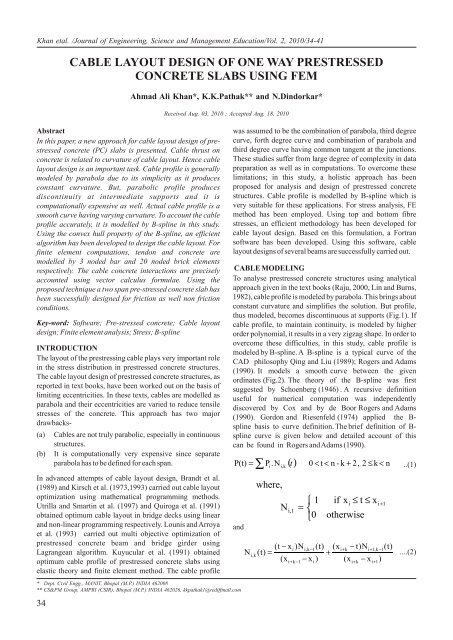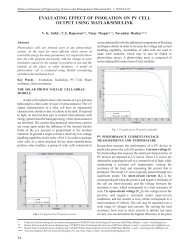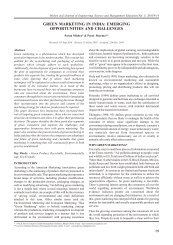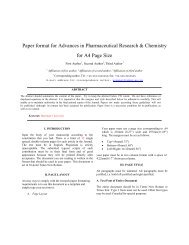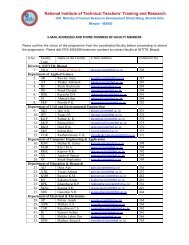Cable layout design of one way prestressed concrete slabs using ...
Cable layout design of one way prestressed concrete slabs using ...
Cable layout design of one way prestressed concrete slabs using ...
Create successful ePaper yourself
Turn your PDF publications into a flip-book with our unique Google optimized e-Paper software.
Journal <strong>of</strong> Engineering, Science and Management EducationIn above equations, P are the n+1 defining polygon vertices,i'sk is the order <strong>of</strong> the B spline and N (t) is called the weighingi,kfunction. x is the additional knot vector which is used for B-spline curve to account for the inherent added flexibility. Aknot vector is simply a series <strong>of</strong> real integers x such thatix x for all x . They are used to indicate the parameter ti i+1 iused to generate a B-spline The curve generally follows theshape <strong>of</strong> the defining polygon and the curve is transformed bytransforming the defining polygonal vertices. The order <strong>of</strong> theresulting curve can be changed without changing the number<strong>of</strong> defining polygon vertices. In Figure : 4 cable reactionconsidering parabolic and B-spline are shown. It can beobserved that B-spline represents the realistic pr<strong>of</strong>ile. Whena B-spline curve is used, the geometrical regularity isautomatically taken into account. Braibant and Fleury(1984), Pourazady et al. (1996) and Ghoddosian(1998) haveused this curve in shape optimization problems and cablegeometry is being modeled as B-spline in this studyFINITE ELEMENT MODELINGFor realistic analysis <strong>of</strong> PC structures advanced computingtechniques such as finite element method has beenextensively employed in literature. Linear finite elementanalysis (FEA) <strong>of</strong> pre-stressed <strong>concrete</strong> structures hasbeen reported by Pandey et al. (1997),Buragohian et al(1993,1997),Pathak et al.(2004. Non linear analysis <strong>of</strong> thesame are reported by Povoas et al. (1989), Kang et al. (1990),Roca et al. (1993), Greunen et al. (1983), Figueiras et al.(1994), Vanzyl et al. (1979) and Elwi et al. (1987). Jirousek etal. (1979) and Buragohain et al. (1993,1997) have consideredcable as parabolic and cubic curve in shell and semilo<strong>of</strong>shell elements, whereas Pandey et al. (1997) considered thecable as parabola in 20 node brick element. Pathak et al.(2004) considered the cable as cubic spline curve in nine nodeLagrangean element. Saleem Akhtar et al. (2008) modelledcable as B-spline for two dimensional finite element analysis.In this study, cable is modeled by three noded bar element and<strong>concrete</strong> by 20 noded brick element (Zienkiewicz and Tayler1991). In Fig.4, a 3 node curved bar element is shown which isembedded in three dimensional 20 node <strong>concrete</strong> element.<strong>Cable</strong> will exert normal and tangential forces on the <strong>concrete</strong>as shown in Fig.5.The shape functions <strong>of</strong> a 3 node curved bar elements along ñaxis are given by-( ρ−1)ρN c 1=2Nc2 = (1 − ρ)(1 + ρ)...................(3)The global coordinates on the curved bar element is given by⎧x⎫⎧x⎫3 3⎪ ⎪ ⎪ ⎪X = ⎨y⎬= ∑⎨y⎬N = ∑X N⎪z⎪⎪z⎪⎩ ⎭ ⎩ ⎭The tangent vector and normal vector along ñ axis for thecable is given by=Where, a is the dot product.ci i cii= 1 i=1dN3ciT = ∑ Xii=1 dρT1⎛ 2⎞⎜ d X a dX ⎟⎜ −2 ⎟dρ T dρ⎝⎠N22a =dρ2dX d X.2dρThe unit tangent and normal vector can be given byTt =| T |Nn =| N |The curvature at any point on the cable is expressed byKdX×dρdρ2d X2=23/2⎧ ⎫⎪ dX⎨⎪ d ρ⎩Now radius <strong>of</strong> curvature can be calculated by :1R =K(4)(5)(6)(7)(8)(9)(10)NORMAL AND TANGENTIAL FORCESThe cable exerts tangential and normal forces on <strong>concrete</strong> dueto intaraction between contacting surfaces and curvature <strong>of</strong>the cable as shown in Fig.5.Tangential and normal forces can be expressed as:⎪⎬⎪⎭N c 3( ρ + 1) ρ=2dTnPt=dX=1TdTndρ(11)35
Journal <strong>of</strong> Engineering, Science and Management EducationTnPn=RNow the resultant force can be computed by(12)In above equation inverse matrix is the jacobian matrix. (x i+1,y i+1, z i+1) and (x i, y i, z i) are the known and computed values <strong>of</strong>the global co-ordinates. Starting values <strong>of</strong> î, ç, æ areconsidered as 0, 0, 0. The prescribed tolerance is 0.01.P = P tt+P n(13)Where T is the tension in the cable and T is the tangent vector.nUsing the principle <strong>of</strong> virtual work, these loads can betransferred to the nodes <strong>of</strong> brick elements. The equivalentnodal force vector for brick element is given by-1T{ PL} = ∫ [ N] P | T | dρ (14)−1<strong>Cable</strong> reaction acts as concentrated loads on the <strong>concrete</strong> atthe ends, where cable is anchoraged. The anchorage end pointforces can be calculated by-(15)Where, T is the cable tension at the end points and [N] is theendshape functions <strong>of</strong> 20 node brick elements. Local coordinatesare required for known global coordinates for calculation <strong>of</strong>anchorage end point forces .This is described in next section.Now total load vector due to interaction <strong>of</strong> <strong>concrete</strong> and cableis obtained by-(16)This nodal load vector is applied on the three dimensionalfinite element model along with live and dead load vectors toinclude pre-stressing effects.LOCAL COORDINATES COMPUTATIONEvaluation <strong>of</strong> local co-ordinate corresponding to knownglobal coordinates is an inverse nonlinear problem which canbe solved by Newton-Raphson method. The computation iscarried out iteratively till the difference <strong>of</strong> two consecutivevalues becomes less than the prescribed tolerance. Let (x,y,z)is the global coordinate and ( î,ç,æ ) be the correspondinglocal co-ordinate. Numerical computations <strong>of</strong> local coordinatescan be obtained <strong>using</strong> following iterativerelationship-⎧ξ⎫⎪ ⎪⎨η⎬⎪ ⎪⎩ς⎭⎧ξ⎫⎪ ⎪= ⎨η⎬⎪ ⎪⎩ς⎭n{}{ P } = [ N] T TA{ }end{ P} = { P} + { P}T L A⎛ ∂x⎜⎜ ∂ξ⎜ ∂y+⎜ ∂ξ⎜∂z⎜⎝ ∂ξ∂x∂η∂y∂η∂z∂η∂x⎞⎟∂ς⎟∂y⎟∂ς⎟∂z⎟⎟∂ς⎠−1⎧ x⎪⎨ y⎪⎩ zi+1i+1− xi⎫⎪− yi ⎬− z ⎪⎭i+ 1ii+1 i....... (17)CABLE LAYOUT DESIGNAn algorithm has been developed to find the cable <strong>layout</strong> sothat stresses in the structural element be below the limitingtensile stress. A check on the compressive stresses will bemade in order to avoid crushing <strong>of</strong> the <strong>concrete</strong>. Based onstress results obtained from finite element analysis, cablepr<strong>of</strong>ile is changed in iterative manner. In the followingsections, these are described in detail.Criterion for Layout DesignOne <strong>of</strong> the main objective <strong>of</strong> the <strong>prestressed</strong> <strong>concrete</strong> <strong>design</strong>is to get rid <strong>of</strong> the tensile stresses from the <strong>concrete</strong>produced due to different loading conditions. In Fig.6 a<strong>prestressed</strong> <strong>concrete</strong> structure is shown. It is assumed thattop fiber at sections 1 and 3 are in tension and bottomfiber at section 2 is in tension. The shape <strong>of</strong> the cable toeliminate the tension should be as shown in the samefigure. The shape <strong>of</strong> the cable can be represented by a B-spline. By varying the ordinates <strong>of</strong> the B-spline, cableshape is changed to get the desired pr<strong>of</strong>ile. It is alsoimportant to know that this would be very difficult if notimpossible with any other curve.Algorithm for Layout DesignIn Fig.7, a <strong>concrete</strong> beam with typical loading is selected forcable <strong>layout</strong> <strong>design</strong>. Assume the cable to be straightbetween anchorage ends and initial prestressing force beP. Now finite element analysis <strong>of</strong> the beam is carried outfor external loads and initial prestressing force P actingat the ends. Let sections 1,2,3,4 and 5 be such that bottomfiber <strong>of</strong> 1, 3 and 5 are in tension and top fiber <strong>of</strong> 2 and4 are in tension. Assume top and bottom stresses at thesesections beitandib, where i varies from 1 to 5.Since stresses at bottom fiber at 1,3 and 5 are in tension,the cable should be concave there, whereas at 2 and 4 itshould be convex. The ordinates <strong>of</strong> B-spline will movedownward at 1,3 and 5 and will move upward at 2 and4. Let the initial y-coordinates <strong>of</strong> these points be y 1,y ,y ,y and y . Depending upon top and bottom fiber2 3 4 5stresses at a point, following four cases may be framed:(a). Top fiber is in tension and bottom fiber is incompression.(b). Bottom fiber is in tension and top fiber is incompression.(c). Both fibers are in tension.(d). Both fibers are in compression.36
Journal <strong>of</strong> Engineering, Science and Management Education(a) Top fiber is in tension and bottom fiber is incompressionLetitandibbe top and bottom stresses, then a ratio R isdefined asR =σitσit+ abs( σ ib)(18)where abs is the absolute value. New y-coordinates <strong>of</strong> theB-spline ordinates are calculated as-i+1= (1 + R y i(19)here y represents the y-coordinate <strong>of</strong> the previousiiteration.(b) Bottom fiber is in tension and top fiber is incompressionLike previous case the stress ratio is defined in thefollowing <strong>way</strong>-R =σy )ibσ+ absib( σ it(20)once again abs represents the absolute value. New y-coordinates <strong>of</strong> the B-spline ordinates are calculated as:y )(21)A check on the compressive stresses at the top fiber will bemade for it to not cross the limiting value.(c) Both Fibers are in TensionIf top and bottom both fibers are in tension, then eitherthe cable force should be increased or the section should bere<strong>design</strong>ed.(d) Both Fibers are in CompressionCheck the compressive stresses at the top and bottom fibersfor them to not cross the limiting value. If they are below,cable pr<strong>of</strong>ile is not altered at that section otherwisere<strong>design</strong> the section.These steps are repeated till the cable pr<strong>of</strong>ile for limitingtensile stresses is obtained. Based on this procedure,ordinate movements <strong>of</strong> B-spline are shown in Fig.7.The flowchart <strong>of</strong> the proposed algorithm is shown in Fig.8.Using this a FORTRAN s<strong>of</strong>tware PRECLAD3D has beendeveloped. The s<strong>of</strong>tware has been successfully run on aPentium IV processor <strong>using</strong> Micros<strong>of</strong>t FORTRAN Powerstation compiler.)i+1= (1 − R y i\7 NUMERICAL EXAMPLESA two span, <strong>one</strong> <strong>way</strong> <strong>prestressed</strong> <strong>concrete</strong> slab <strong>of</strong>8000x2000x400 mm is <strong>design</strong>ed <strong>using</strong> PRECLAD3Ds<strong>of</strong>tware for friction and non friction conditions. The slab isdiscretised into 50 twenty node brick elements and 428nodes. The loading conditions and FE model are shown inFig.9. Two line loads are applied in each span <strong>of</strong> the slab.Corresponding nodal point loads in terms <strong>of</strong> A, B, C are 20, 40and 10 KN respectively. P is the prestressing force. Followingmaterial properties are used for the <strong>design</strong> purposes-4 2(a). Young's modulus (<strong>concrete</strong>) = 2x10 N/mm2(b). Compressive strength <strong>of</strong> <strong>concrete</strong> = 40 N/mm(c). Poisson's ratio = 0.15-5(d). Wobble coeffient = 1x10(e) Coefficient <strong>of</strong> friction = 0.202(f). Tensile strength <strong>of</strong> <strong>concrete</strong> = 0.25 N/mm .3(g). Density <strong>of</strong> <strong>concrete</strong> = 2500 Kg/mThe limiting tensile stress is considered as 0.25 MPa. Because<strong>of</strong> symmetry cables 1,2 and and 4, 5 will have same pr<strong>of</strong>ile.In Table 1, top and bottom bending stresses at differentsections for without friction condition are given. The intialthprestressing force is 480 KN. It can be observed that in 12iterations, tensile stresses are below the limiting value. Thefinal prestressing force is 494 KN. <strong>Cable</strong> eccentricities interms <strong>of</strong> polygon and B-spline ordinates are given in Table 2.In Table 3, top and bottom bending stresses at differentsections for friction condition are given. The intialthprestressing force is 560 KN. It can be observed that in 7iterations, tensile stresses are below the limiting value. Thefinal prestressingn force is 588 KN. <strong>Cable</strong> eccentricities interms <strong>of</strong> polygon and B-spline ordinates are given in Table 4.The percentage increase in the final load with respect to that <strong>of</strong>non friction case is 19% which is required to overcomefriction.CONCLUSIONSIn this paper a new technique for cable <strong>layout</strong> <strong>design</strong> <strong>of</strong><strong>prestressed</strong> <strong>concrete</strong> <strong>slabs</strong> is presented. The pre-stressingcables are modelled as B-spline curve. Friction loss <strong>of</strong> theprestressing force is also accounted. The cable segment in thefinite element is modelled by three node bar element. Thisapproach is coded in a 3D FE s<strong>of</strong>tware <strong>using</strong> which two<strong>prestressed</strong> <strong>concrete</strong> <strong>slabs</strong> have been successfully <strong>design</strong>ed. Itis hoped that the proposed approach will prove to be aneffective tool <strong>of</strong> the <strong>design</strong> engineers in realistic <strong>design</strong> <strong>of</strong> PC<strong>slabs</strong>.37
Journal <strong>of</strong> Engineering, Science and Management EducationItNo1.2.3.4.5.6.7.8.9.10.11.12.Load(KN)480480480480480480480490490490493494Table 1: Bending stresses (MPa) (without friction)Section <strong>Cable</strong> 1 <strong>Cable</strong> 2 <strong>Cable</strong> 3Top Bottom Top Bottom Top Bottom1-1 -6.366 0.292 -6.348 0.233 -6.336 0.2132-2 0.350 -6.661 0.486 -6.452 0.501 -6.4463-3 -6.375 -0.306 -6.350 0.248 -6.338 0.2281-1 -6.271 0.198 -6.254 0.141 -6.243 0.1212-2 0.277 -6.586 0.412 -6.378 0.427 -6.3723-3 -6.271 0.203 -6.247 0.146 6.236 0.1271-1 -6.191 0.118 -6.175 0.062 -6.164 0.0432-2 0.247 -6.556 0.381 -6.349 0.397 -6.3433-3 -6.239 0.172 -6.215 0.114 -6.204 0.0951-1 -6.154 0.083 -6.140 0.027 -6.129 0.0082-2 0.220 -6.529 0.354 -6.323 0.370 -6.3173-3 -6.171 0.105 -6.148 0.048 -6.137 0.0291-1 -6.124 0.053 -6.110 0.002 -6.099 -0.0212-2 0.208 -6.518 0.343 -6.312 0.359 -6.3083-3 -6.128 0.062 -6.105 0.006 -6.095 -0.0121-1 -6.098 -0.027 -6.084 -0.027 -6.073 -0.0462-2 0.205 -6.516 0.341 -6.312 0.358 -6.3083-3 -6.098 0.033 -6.076 -0.022 -6.065 -0.0421-1 -6.074 0.004 -6.061 -0.050 -6.050 -0.0692-2 0.212 -6.524 0.348 -6.322 0.366 -6.3183-3 -6.082 0.016 -6.059 -0.039 -6.048 -0.0581-1 -6.116 -0.080 -6.103 -0.134 -6.092 -0.1532-2 0.133 -6.573 0.270 -6.367 0.288 -6.3633-3 -6.123 -0.067 -6.101 -0.123 -6.091 -0.1421-1 -6.098 -0.097 -6.085 --0.152 -6.074 -0.1712-2 0.137 -6.578 0.275 -6.373 0.293 -6.3703-3 -6.106 -0.084 -6.083 -0.140 -6.073 -0.1591-1 -6.140 -0.056 -6.127 -0.110 -6.116 -0.1292-2 0.126 -6.565 0.262 -6.357 0.279 -6.3523-3 -6.140 -0.050 -6.118 -0.106 -6.108 -0.1251-1 -6.152 -0.081 -6.139 -0.135 -6.129 -0.1542-2 0.102 -6.580 0.239 -6.370 0.256 -6.3663-3 -6.153 -0.075 -6.131 -0.131 -6.121 -0.1501-1 -6.157 -0.089 -6.144 -0.144 -6.133 -0.1632-2 0.094 -6.584 0.231 -6.375 0.248 -6.3703-3 -6.157 -0.083 -6.135 -0.139 -6.125 -0.158Table 2: <strong>Cable</strong> eccentricity (mm) at different sections (without friction)<strong>Cable</strong> No <strong>Cable</strong>1 <strong>Cable</strong>2 <strong>Cable</strong>3Distance from left end 0 1600 4000 6400 8000 0 1600 4000 6400 8000 0 1600 4000 6400 8000(mm)ItNoLoad(KN)Ordinate1. 480 Polygon 200 150 250 150 200 200 150 250 150 200 200 150 250 150 200B-spline 200 178.40 200 178.40 200 200 178.40 200 178.40 200 200 178.40 200 178.45 2002. 480 Polygon 200 143.42 262.48 148.12 200 200 144.68 267.51 144.36 200 200 145.12 268.03 144.79 200B-spline 200 176.59 202.87 176.41 200 200 178.24 206.01 178.05 200 200 178.6 206.49 178.41 2003. 480 Polygon 200 139.03 273.07 143.47 200 200 141.49 283.74 141.06 200 200 142.4 284.86 141.9 200B-spline 200 175.86 207.16 178.42 200 200 179.15 212.50 178.90 200 200 179.9 213.5 179.61 2004. 480 Polygon 200 136.42 282.98 139.62 200 200 140.08 299.80 138.52 200 200 141.41 301.63 139.75 200B-spline 200 175.99 210.50 177.84 200 200 181.10 219.55 180.20 200 200 182.23 221.10 181.28 2005. 480 Polygon 200 134.60 292.20 137.28 200 200 139.47 315.69 137.45 200 200 141.22 318.32 139.09 200B-spline 200 176.50 214.07 178.05 200 200 183.53 227.07 182.36 200 200 185.05 229.23 183.82 2006. 480 Polygon 200 133.44 301.23 135.90 200 200 139.47 331.96 137.31 200 200 141.22 335.46 139.09 200B-spline 200 177.38 217.95 178.8 200 200 186.38 235.17 185.14 200 200 188.06 237.80 186.84 2007. 480 Polygon 200 133.44 310.42 136.54 200 200 139.47 348.97 137.31 200 200 141.22 353.47 139.09 200B-spline 200 179.01 222.70 180.80 200 200 189.31 243.68 188.13 200 200 191.23 246.81 190.01 2008. 490 Polygon 200 133.44 310.42 136.54 200 200 139.47 348.97 137.31 200 200 141.22 353.47 139.09 200B-spline 200 179.01 222.70 180.80 200 200 189.31 243.68 188.13 200 200 191.23 246.81 190.01 2009. 490 Polygon 200 133.44 316.57 136.54 200 200 139.47 363.17 137.31 200 200 141.22 368.77 139.09 200B-spline 200 180.09 225.78 181.88 200 200 191.88 250.78 190.63 200 200 193.93 254.46 192.70 20010. 490 Polygon 200 133.44 301.23 135.90 200 200 139.47 331.96 137.31 200 200 141.22 335.46 139.09 200B-spline 200 177.38 217.95 178.8 200 200 186.38 235.17 185.14 200 200 188.06 237.8 186.84 20011. 493 Polygon 200 133.44 301.23 135.90 200 200 139.47 331.96 137.31 200 200 141.22 335.46 139.09 200B-spline 200 177.38 217.95 178.80 200 200 186.38 235.17 185.14 200 200 188.06 237.80 186.84 20012. 494 Polygon 200 133.44 301.23 135.90 200 200 139.47 331.96 137.31 200 200 141.22 335.46 139.09 200B-spline 200 177.38 217.95 178.80 200 200 186.38 235.17 185.14 200 200 188.06 237.80 186.84 20038
Journal <strong>of</strong> Engineering, Science and Management EducationItNo1.2.3.4.5.6.7.Load(KN)560560560560570580588Table 3: Bending stresses (MPa) (with friction)Section <strong>Cable</strong> 1 <strong>Cable</strong> 2 <strong>Cable</strong> 3Top Bottom Top Bottom Top Bottom1-1 -6.938 0.536 -6.917 0.474 -6.902 0.4532-2 0.361 -6.991 0.504 -6.773 0.521 -6.7673-3 -6.383 0.095 -6.360 0.048 -6.349 -0.0681-1 -6.705 0.330 -6.686 0.270 -6.673 0.2502-2 0.307 -6.991 0.450 -6.694 0.467 -6.6883-3 -6.398 0.050 -6.375 -0.007 -6.364 -0.0261-1 -6.561 0.206 -6.544 0.148 -6.531 0.1282-2 0.283 -6.866 0.425 -6.651 0.442 -6.6463-3 -6.396 0.068 -6.373 0.010 -6.362 -0.0091-1 -6.473 0.136 -6.457 0.079 -6.445 0.0592-2 0.274 -6.840 0.416 -6.627 0.434 -6.6223-3 -6.370 0.060 -6.347 0.003 -6.337 -0.0161-1 -6.516 0.066 -6.500 0.009 -6.488 -0.0092-2 0.207 -6.888 0.350 -6.671 0.368 -6.6663-3 -6.411 -0.010 -6.389 -0.067 -6.378 -0.0871-1 -6.558 -0.063 -6.544 -0.059 -6.532 -0.0792-2 0.140 -6.935 0.285 -6.715 0.302 -6.7093-3 -6.452 -0.081 -6.430 -0.138 -6.419 -0.1581-1 -6.592 -0.059 -6.578 -0.115 -6.566 -0.1352-2 0.086 -6.973 0.232 -6.750 0.250 -6.7443-3 -6.484 -0.138 -6.463 -0.194 -6.453 -0.214Table 4: <strong>Cable</strong> eccentricity(mm) at different section-with friction<strong>Cable</strong> No <strong>Cable</strong> 1 <strong>Cable</strong> 2 <strong>Cable</strong> 3Distance from left end 0 1600 4000 6400 8000 0 1600 4000 6400 8000 0 1600 4000 6400 8000(mm)ItNoLoad(KN)Ordinate1. 560 Polygon 200 150 250 150 200 200 150 250 150 200 200 150 250 150 200B-spline 200 178.40 200 178.40 200 200 178.40 200 178.40 200 200 178.40 200 178.45 2002. 560 Polygon 200 139.42 262.27 147.80 200 200 140.38 267.31 150 200 200 140.76 267.87 150 200B-spline 200 174.26 202.94 179.08 200 200 175.71 206.25 181.29 200 200 176.07 206.62 181.39 2003. 560 Polygon 200 132.88 273.30 146.65 200 200 134.93 284.14 150 200 200 135.67 285.35 150 200B-spline 200 172.31 206.53 180.24 200 200 175.48 213.30 184.16 200 200 176.13 214.09 184.39 2004. 560 Polygon 200 128.83 284.12 145.10 200 200 131.94 301.20 149.76 200 200 133.06 303.14 150 200B-spline 200 171.79 210.54 181.16 200 200 176.71 221.02 186.98 200 200 177.72 222.33 187.48 2005. 570 Polygon 200 128.83 284.12 145.10 200 200 131.94 301.20 149.76 200 200 133.06 303.14 150 200B-spline 200 171.79 210.54 181.16 200 200 176.71 221.02 186.98 200 200 172.72 222.33 187.48 2006. 580 Polygon 200 128.83 284.12 145.10 200 200 131.94 301.20 149.76 200 200 133.06 303.14 150 200B-spline 200 171.79 210.54 181.16 200 200 176.71 221.02 186.98 200 200 177.72 222.33 187.48 2007. 588 Polygon 200 128.83 284.12 145.10 200 200 131.94 301.20 149.76 200 200 133.06 303.14 150 200B-spline 200 171.79 210.54 181.16 200 200 176.71 221.02 186.98 200 200 177.72 222.33 187.48 200ParabolicActualFig. 1 : Actual <strong>Cable</strong> & Parabolic Pr<strong>of</strong>ileFig. 2 : B-Spline Pr<strong>of</strong>ile39
Journal <strong>of</strong> Engineering, Science and Management EducationFig. 3a : Parabolic Pr<strong>of</strong>ileFig. 6 : Required <strong>Cable</strong> Pr<strong>of</strong>ileFig. 3b : B-Spline Pr<strong>of</strong>ileFig. 7 : Variation <strong>of</strong> <strong>Cable</strong> Pr<strong>of</strong>ileStartSelection <strong>of</strong> slab loading, <strong>Cable</strong>Pr<strong>of</strong>ileChange the cablepr<strong>of</strong>ileNoIf stressesareincreasingYesIncrease the loadsNoFinite Element modelling,Boundary conditionsFinite Element analysis, Study<strong>of</strong> bending stressesAre the stressesbelow limitingvalue?Yes<strong>Cable</strong> Layout completedStopFig. 4 : Brick Element with Curved Bar ElementFig. 8 : Flowchart for <strong>Cable</strong> Layout DesignFig. 8: Flow chart for cable <strong>layout</strong> <strong>design</strong>Fig. 5 : Forces on Concrete Due to <strong>Cable</strong> Tension.Fig. 9 : One<strong>way</strong> Prestressed Concrete Slab.40
Journal <strong>of</strong> Engineering, Science and Management EducationREFERENCES1. A.M. Brandt. “Foundations <strong>of</strong> Optimum Design in CivilEngineering,” Nijh<strong>of</strong>f Publishers, 1989.2. V. Braibant , C. Fleury, P. Beckers. “Shape optimal<strong>design</strong>: An approach matching CAD and optimizationconcept,” Report SA-109, Aerospace Laboratory <strong>of</strong>University <strong>of</strong> Liege, Belgium, 1983.3. D.N. Buragohian , A. Mukherjee. “PARCS –A <strong>prestressed</strong>and reinforced <strong>concrete</strong> shell element forthanalysis <strong>of</strong> containment structures,” Transac. <strong>of</strong> 12SmiRT Int. Conf, Vol. B, Stuttgart, Germany, 1993.4. D.N. Buragohian, U.R. Siddhyae. “Finite elementanalysis <strong>of</strong> pre stressed <strong>concrete</strong> box girder bridges,” J.Struc. Engg. Div., 24(3), 135-141, 1997.5. A. Elwi , T. Hrudey. “Finite element model for curvedcable embedded reinforcement,” J. Engg. Mech.ASCE, 115 (4), 740-754, 1989.6. J.A. Figueiras , R.H.C.F. Povoas. “Modeling <strong>of</strong> prestressingin non -linear analysis <strong>of</strong> <strong>concrete</strong> structures,”Comput. & Struc., 53(1), 173-187,1994.7. A. Ghoddosian. “Improved Zero Order Techniques forStructural Shape Optimization Using FEM,” PhDDissertation, Applied Mechanics Dept. IIT Delhi, 1998.8. W.J. Gordon, R.F. Riesenfeld . “Computer AidedGeometric Design,” Academic Press, London, 1974.9. J.V. Greunen, A.C. Scordelis. “Nonlinear analysis <strong>of</strong>pre-stressed <strong>concrete</strong> <strong>slabs</strong>,” J. Struct. Engg. Div.,ASCE, 109 (7), 1742-1760, 1983.10. J. Jirousek , A. Bouberguig , A. Saygun . “A macroelement analysis <strong>of</strong> pre-stressed curved box girderbridges” Comput. & Struc., 10, 467-482, 1979.11. Y.J. Kang , A. C. Scordelis. “Non-linear analysis <strong>of</strong> <strong>prestressed</strong><strong>concrete</strong> frames,” J. Struct. Engg. Div., ASCE,106(2), 445-462, 1990.12. U. Kirsch. “Optimized prestressing by linearprogramming,” Int. J. Num. Meth. Engg., 7, 125-136,1973.13. U. Kirsch. “Structural Optimization, Springer-Verlog,Berlin, 1993.14. A. Kuyucular. “Prestressing optimization <strong>of</strong> <strong>concrete</strong><strong>slabs</strong>,” J. Struct. Engg. Div., ASCE, 117, 235-254,1991.15. Z. Lounis , M.Z. Cohn. “Multi objective optimization<strong>of</strong> <strong>prestressed</strong> <strong>concrete</strong> structures,” J. Struct. Engg.Div., ASCE, 119, 794-808, 1993.16. T.Y Lin, N.H. Burns. “Design <strong>of</strong> pre-stressed<strong>concrete</strong> structures,” Third Edition, John Wiley andSons. Inc., New York, 1982.17. A.K. Pandey, R. Kumar, D.N. Trikha. “Finite elementanalysis <strong>of</strong> pre-stressed <strong>concrete</strong> containmentstructures,” Proceedings <strong>of</strong> first internationalconference on computer aided analysis and <strong>design</strong>,Hyderabad, India, 373-379, 1997.18. K.K. Pathak, D. K. Sehgal. “Analysis <strong>of</strong> pre-stress<strong>concrete</strong> beams <strong>using</strong> different cable models,” J. Bridgeand Struc. Engg., 33, 2004.19. M. Pourazady , Z. Fu . “An integrated approach tostructural shape optimization,” Comput. and Struct.,60, 279-289,1996.20. R.H.C.F Povoas, J.A. Figueiras. “Non linear analysis <strong>of</strong>curved pre-stressed girder bridges,”. Proceedings <strong>of</strong>second international conference on computer aidedanalysis and <strong>design</strong>, Austria, 1989.21. S.B. Qing, D.Y. Liu . “Computational geometry- Curveand Surface Modeling,” Academic Press, London,1989.22. A.S. Quiroga,n M.A.U Arroya. “Optimization <strong>of</strong><strong>prestressed</strong> <strong>concrete</strong> bridge decks,” Comput. andStruct., 41, 553-559, 1991.23. N.K. Raju. “Pre-stressed Concrete,” Third Edition,New Delhi, Tata Mc -Graw Hill, 1995.24. P. Roca, A.R. Mari. “Numerical treatment <strong>of</strong> prestressingtendons in the non- linear analysis <strong>of</strong> <strong>prestressed</strong><strong>concrete</strong> structures,” Comput. and Struc., 46(950), 905-916 , 1993.25. D.F. Rogers, J.A. Adams . “Mathematical Element forcomputer Graphics,” Second Edition, McGraw-Hill,New York,1990.26. S. Akhtar, K.K. Pathak, S.S. Bhaduria. “Finite elementanalysis <strong>of</strong> pre-stress <strong>concrete</strong> beams consideringrealistic cable pr<strong>of</strong>ile,” Int. J. Appl. Engg., Res.,, 3(1) ,2008.27. I.J. Schoenberg. “Contribution to the problem <strong>of</strong>approximation <strong>of</strong> equidistant data by analyticfunctions,” Quarterly <strong>of</strong> Appl. Math., 4 ,45-99, 1946.28. M.A. Utrilla, A. Smartin . “Optimized <strong>design</strong> <strong>of</strong> theprestress in continuous bridge decks,” Comput. andStruct., 64, 719-728,1997.29. S.F. Vanzyl, A.C. Scordelis. “Analysis <strong>of</strong> curved <strong>prestressed</strong>segmental bridges,” J. Struc. Engg., ASCE,105, 2399 -2411,1979.30. O.C. Zienkiewicz, R.L. Taylor. The Finite ElementMethod Vol. 1&2, Fourth Edition: McGraw -HillLondon, 1991.41


